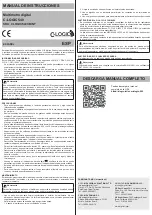
A
V
V
AUTO POWER OFF
830L+ Digital Multimeter Operation Manual
It’s very helpful that reading the operation manual to familiar with how to operate and maintenance the device
before operation.
1.
Appearance Introduction
1-1.
Display
3
½
LCD with 20mm high figure display.
1-2.
Function Keys
SELECT:
select
or
function
under
status. The device goes to sleep when stopping the operation for 15 minutes,
and re-powers on when press the function key or toggle the function switch.
HOLD/
:
⑴
Data hold: press this key for a short time, the current measuring value of the device will be hold on the LCD and “H” symbol
will be displayed. Press it again can exit the HOLD mode.
⑵
Backlight: press this key for more than 2 seconds to turn on the LCD backlight. The LCD backlight will be turned off
automatically after 15 seconds, or turned off by press this key again for more than 2 seconds.
1-3.
Range rotary switch
This device is adapting rotary type switch, it combines function selection, range selection and power switch into
one role. To extend the battery life, the rotary switch should be turned to “OFF” position if the device is not be
used.
1-4.
Input Terminal
“VΩmA”: Input terminal for Voltage, Resistance and less than 200mA current.
“COM”: Input terminal for common GND.
“10A”: Input terminal for more than 200mA current.
“NPN/PNP”: Input terminal for triode measurement.
1-5.
The top of the LCD is non-contact voltage (NCV) detector area.
1-6.
Holster and battery door.
2.
General Features
Display: 3
½
LCD, Max. display 1999.
Polarity: Automatic polarity display.
Over-range display: Display “1”.
Working environment: (0~40)
℃
, relative humidity <75%.
Storage environment: (-15~50)
℃
.
Battery: 2pcs 1.5V battery (“AAA” 7# battery).
Battery life: About 200 hours for alkaline battery, and 100 hours for carbon battery.
Dimension&Weight: 140mm(L) x 72mm(W) x 37mm(H), N.W: 195g
Low battery indication: LCD displays ”
”
3.
Technical Features
Environment condition: Temperature: 23
°
C±5
°
C, Relative humidity: <75%. Accuracy: ± (a% × reading data + digits), one
year guarantee since production date.
3-1. DCV
Range
Resolution
Accuracy
200mV
100uV
±(0.5% r 4)
2000mV
1mV
20V
10mV
200V
100mV
600V
1V
Input impedance: 200mV range >40MΩ, other ranges is 10MΩ.
Overload protection: 600V DC/AC RMS.
3-2. DCA
Range
Resolution
Accuracy
20uA
10nA
±(1.0% r 5)
2mA
10uA
200mA
100uA
±(2.0% r 5)
10A
10mA
Overload protection: 0.2A/250V fuse, 10A/250V fuse.
3-3. ACV
Range
Resolution
Accuracy
200V
100mV
±(1.0% r 6)
600V
1V
Frequency response: 40-400Hz.
Overload protection: 600V DC RMS or AC RMS.
Displaying: True RMS response (calibration based on sine wave RMS).
3-4. Resistance
Range
Resolution
Accuracy
200Ω
0.1Ω
±(0.8% r 5)
2kΩ
1Ω
±(0.8% r 1)
20kΩ
10Ω
2MΩ
1kΩ
200MΩ
100kΩ
±(1.2% r 5)
Open circuit voltage:
>
500mV
Overload protection: 250V DC/AC peak value.
3-5. Transistor (hFE)
Measurement
Range
Test conditions
hFE NPN or PNP
0
~
1000
Base current is approx 15μA, Vce is
about 1.2V
3-6. Diode and Continuity Test
Measurement
Range
Test conditions
Diode forward voltage drop
Forward DC current: 0.8mA, open circuit
voltage: 2.2V.
When the resistance under
test is less than 50Ω, buzzer
sounds continuously.
Open circuit voltage: 2V
Overload protection: 250V DC/AC peak value.
WARNING: Do not input any voltage at this range!
4.
OPERATION
4-1. DCV measurement
A.
Insert the red test lead into “VΩmA” terminal, and the black one into “COM” terminal;
B.
Turn the rotary switch to DCV position and select the proper range, if users not sure about the range, then
select the highest range;
C.
Connect the red and the black test leads to the tested circuit.
4-2. DCA measurement
A.
Insert the black test lead into “COM” terminal and the red one into “VΩmA” terminal (less than 200mA) or
into ”10A” terminal (more than 200mA);
B.
Turn the rotary switch to the proper DCA range position;
C.
Connect the red and the black test leads to the tested circuit.
4-3. ACV measurement (TRMS)
A.
Insert the red test lead into “VΩmA” terminal, and the black one into “COM” terminal;




















